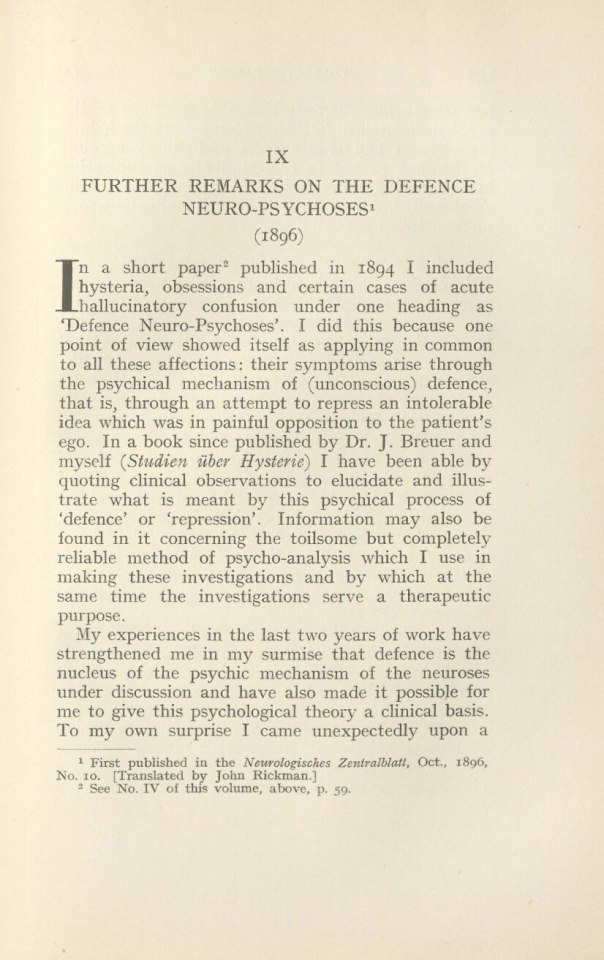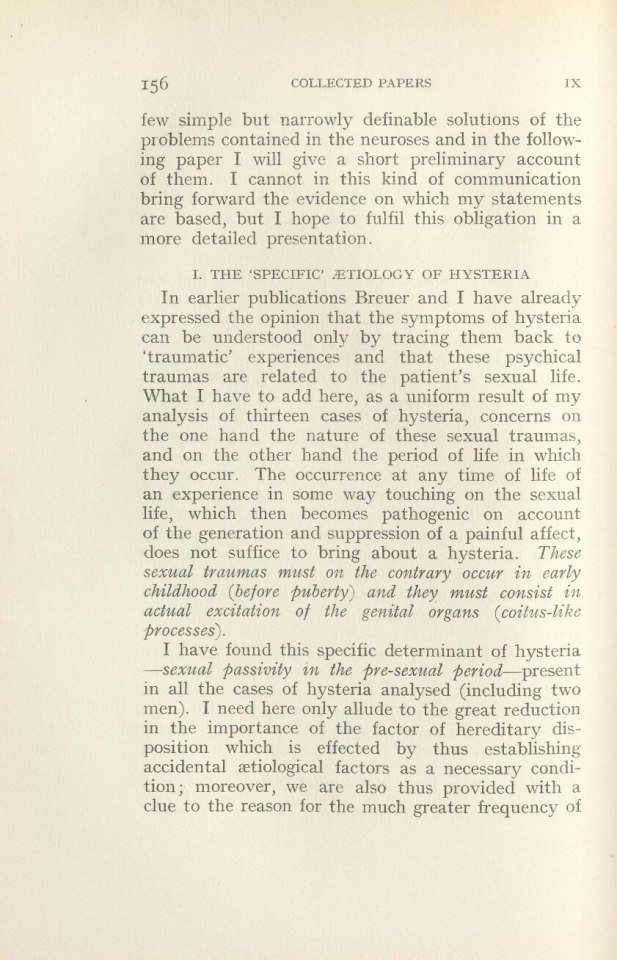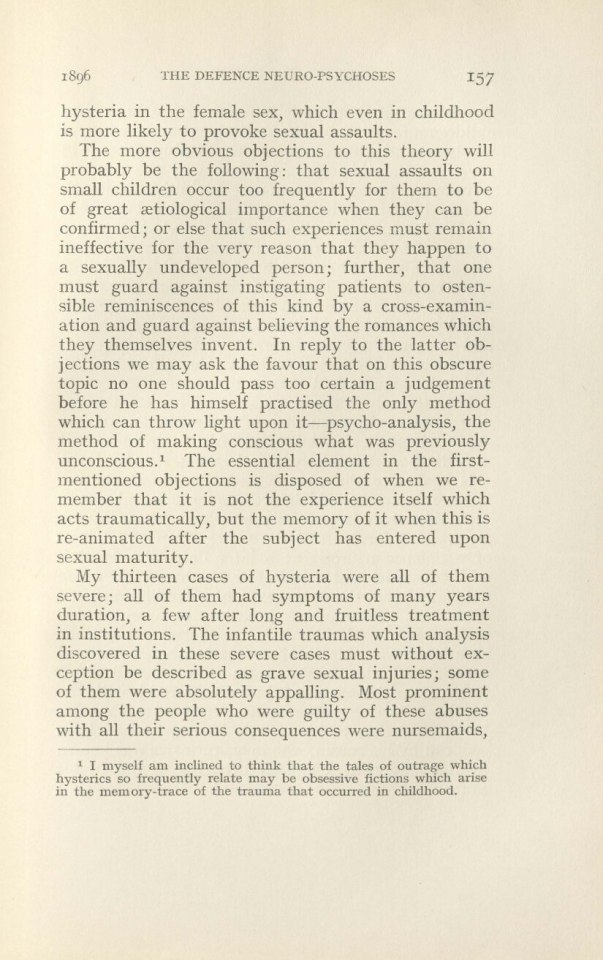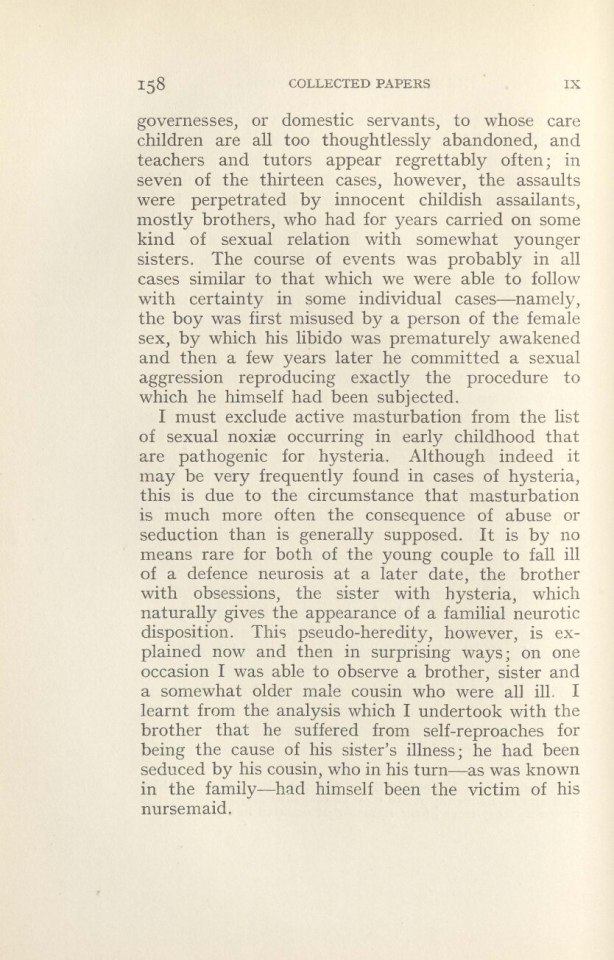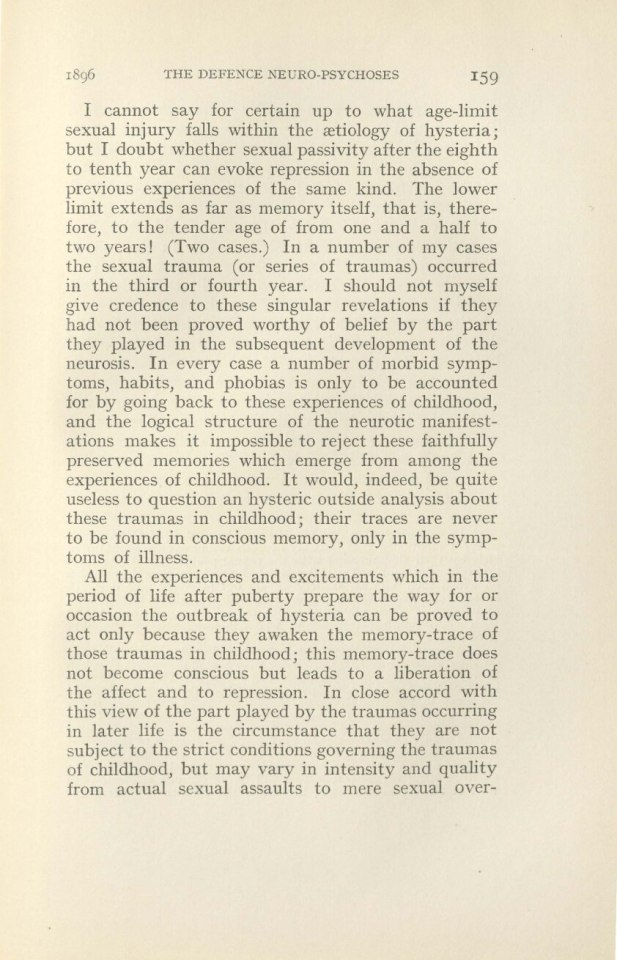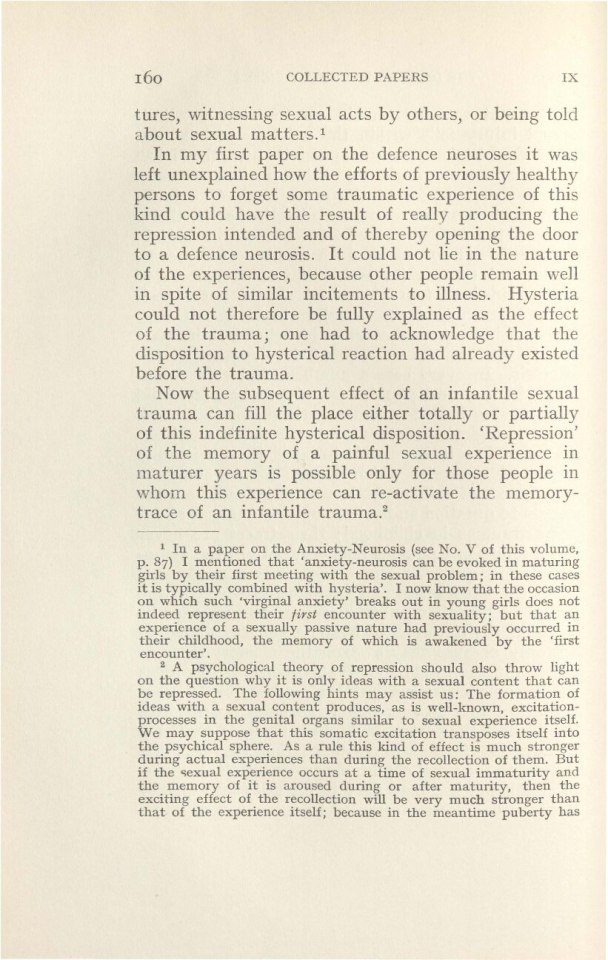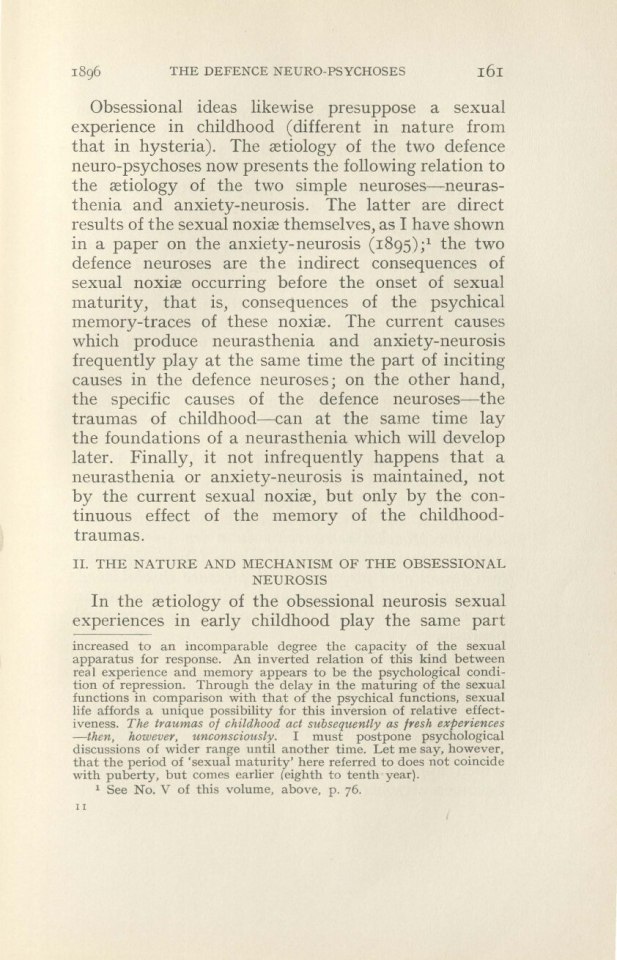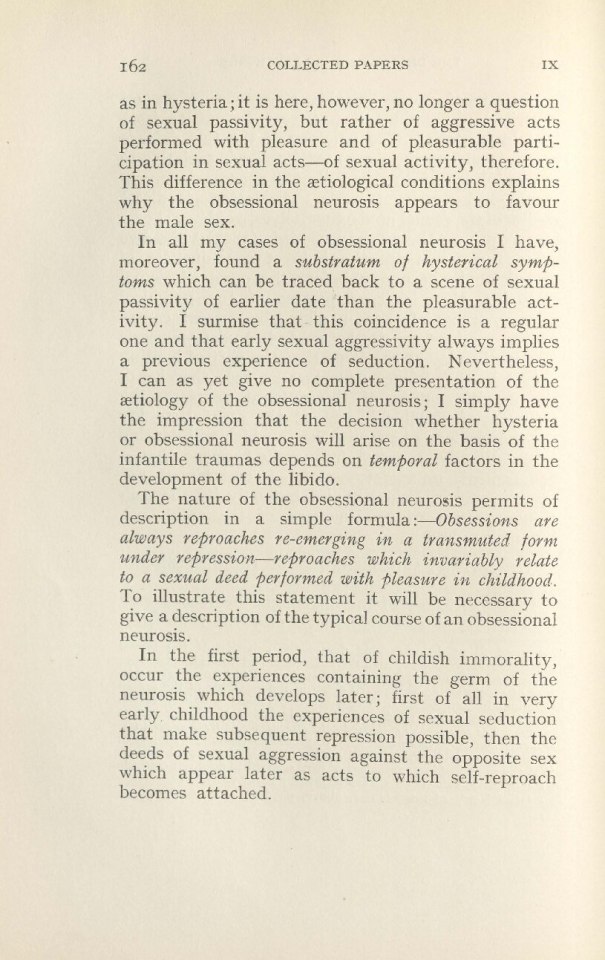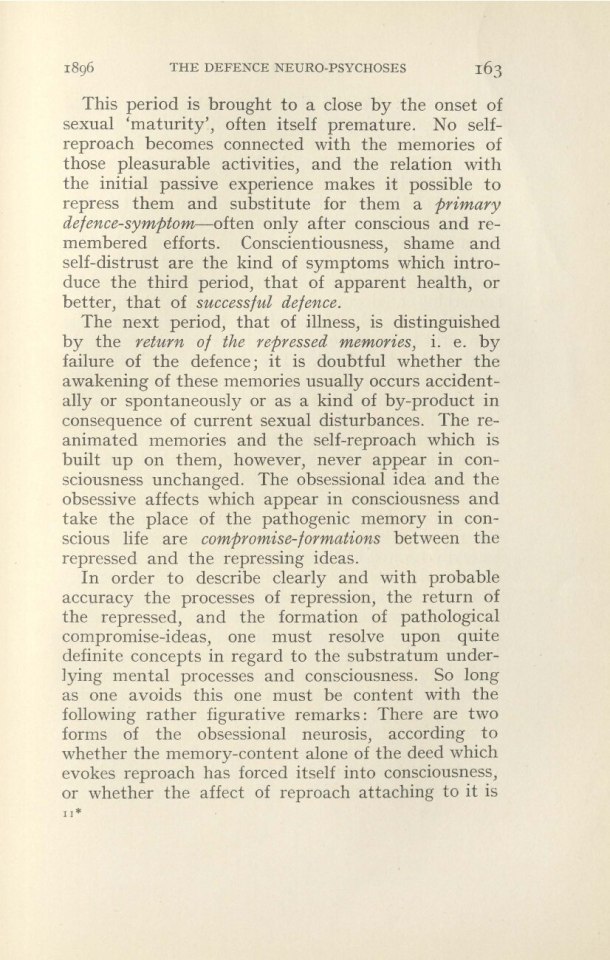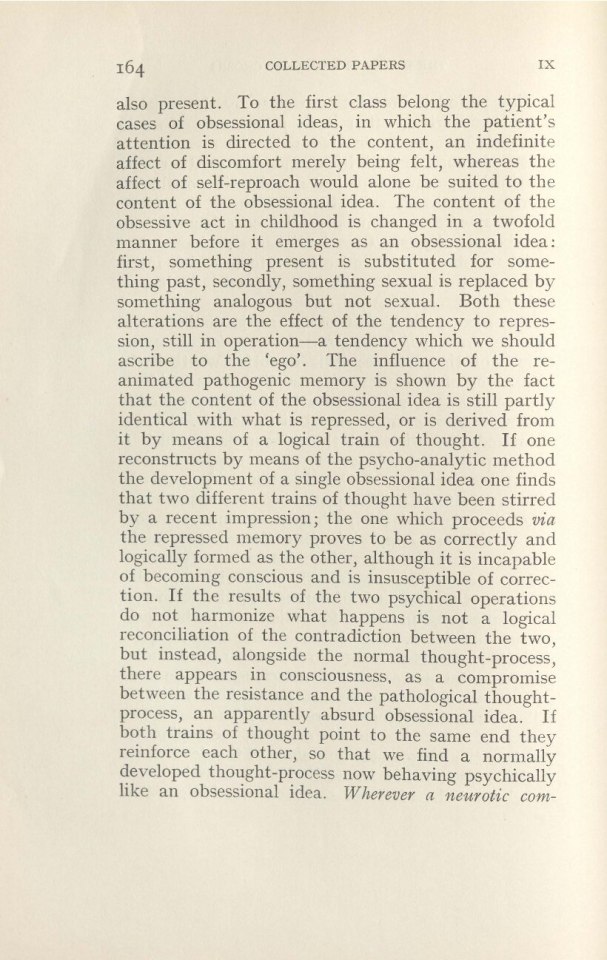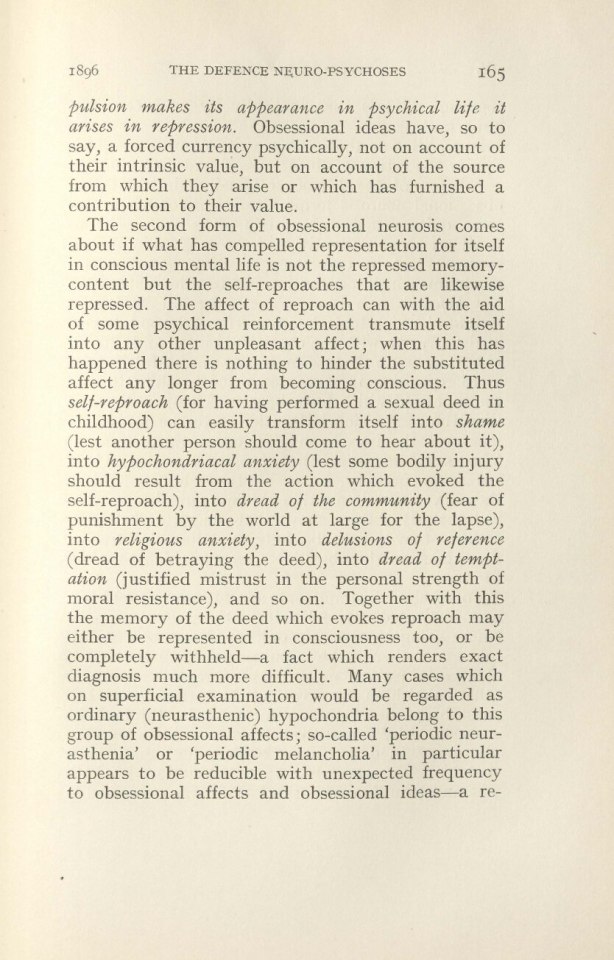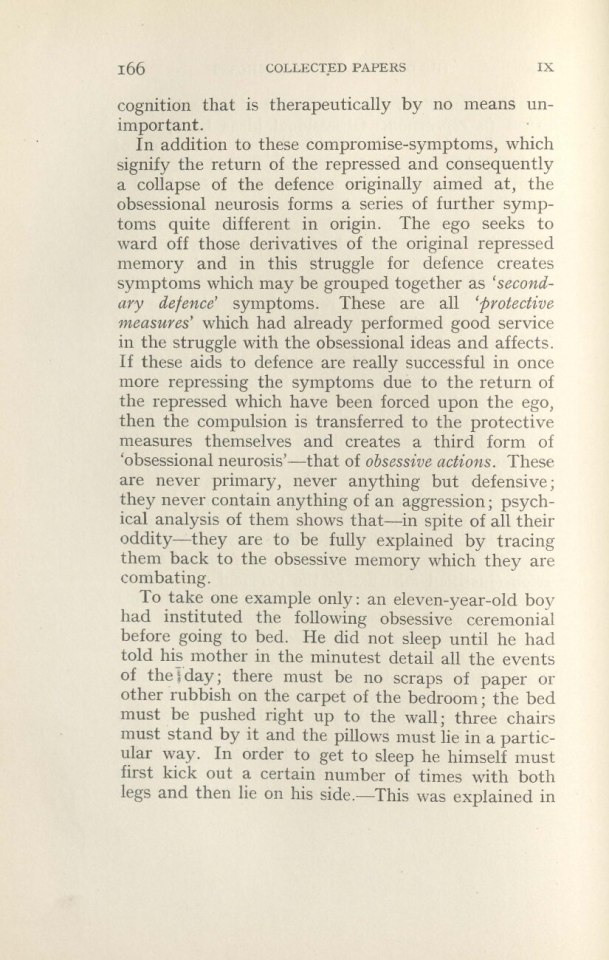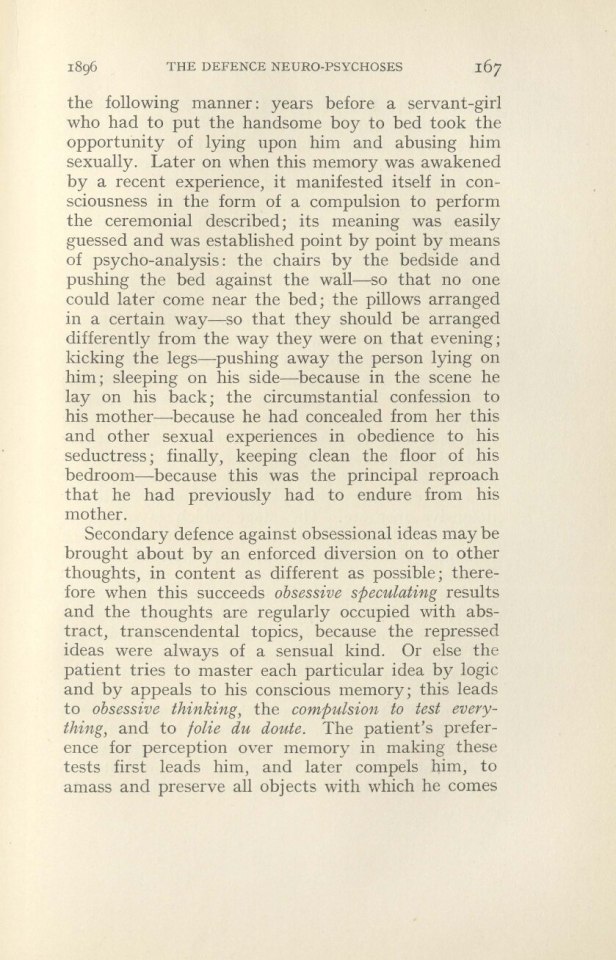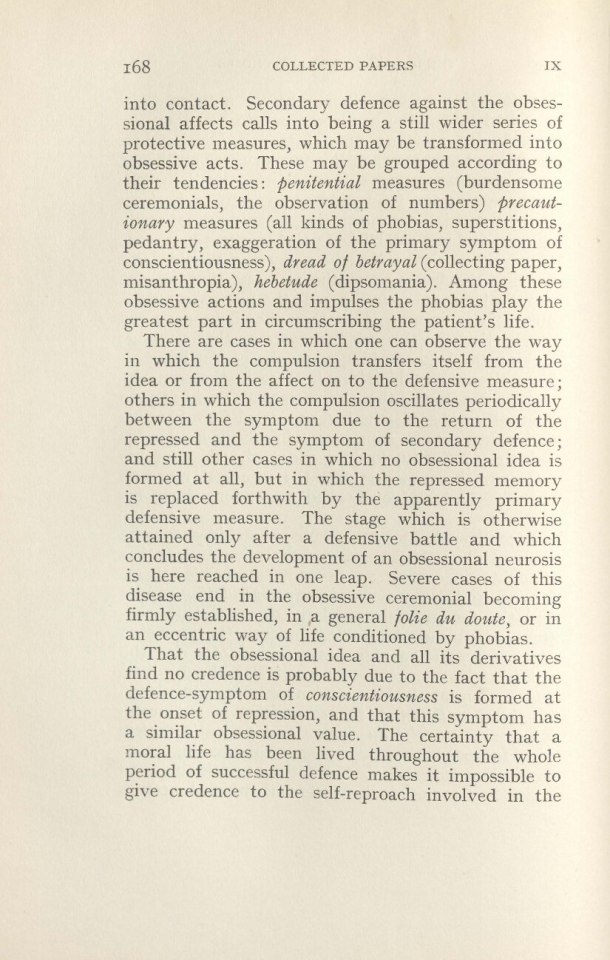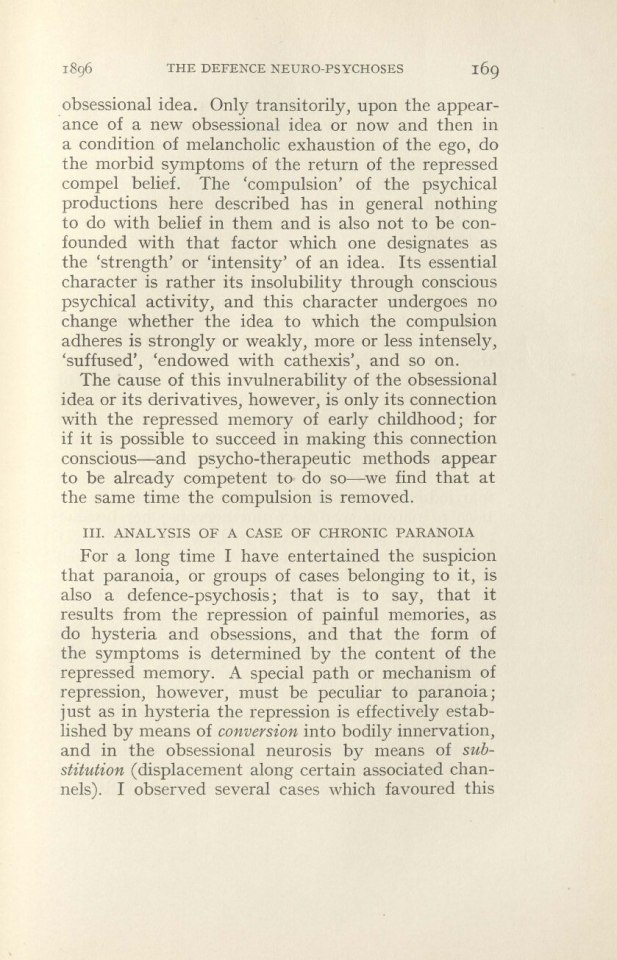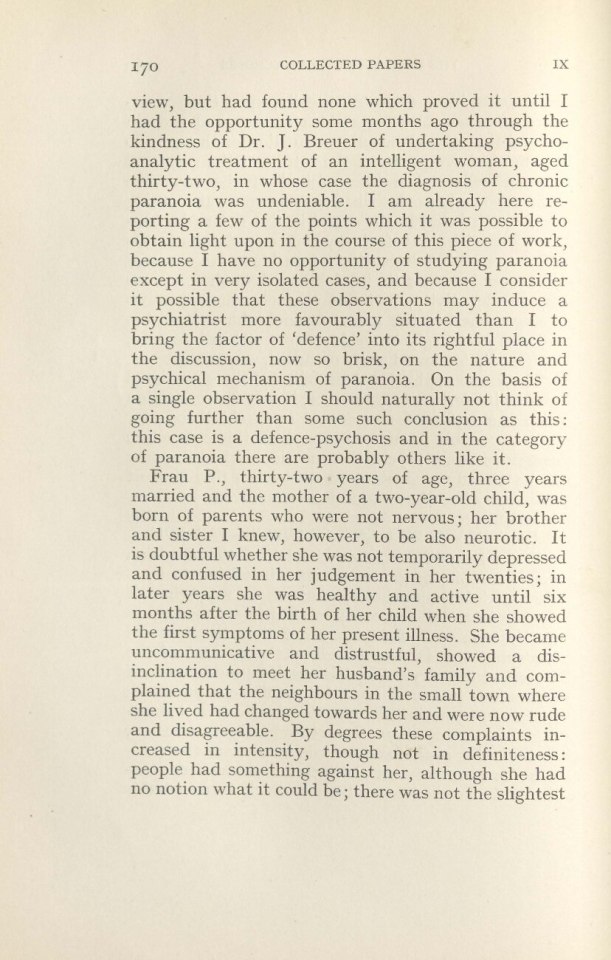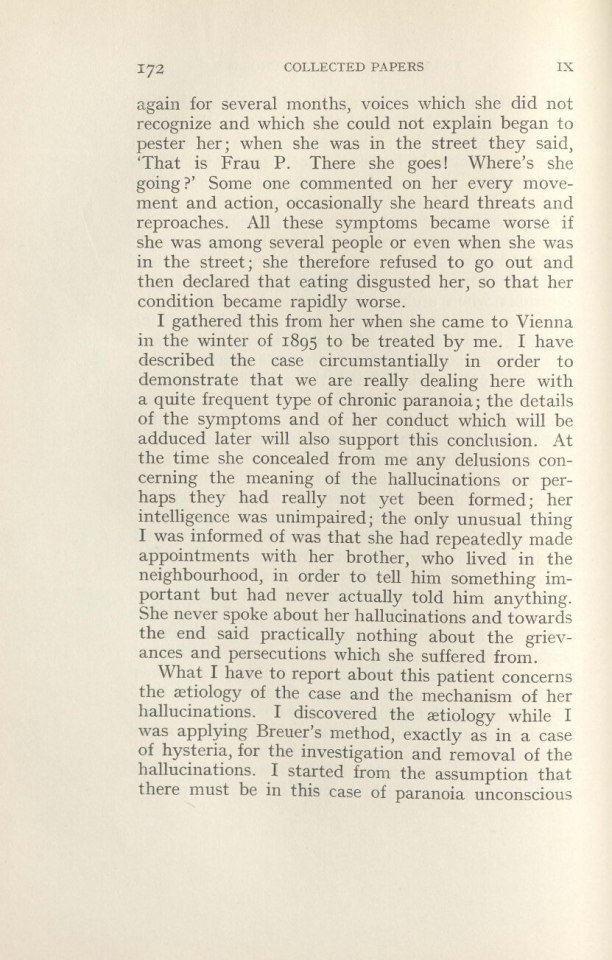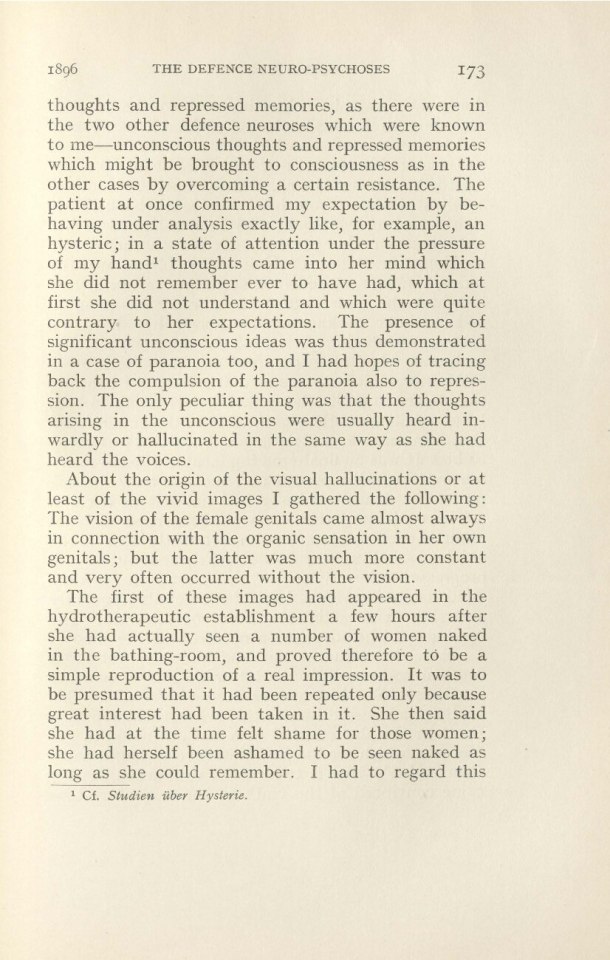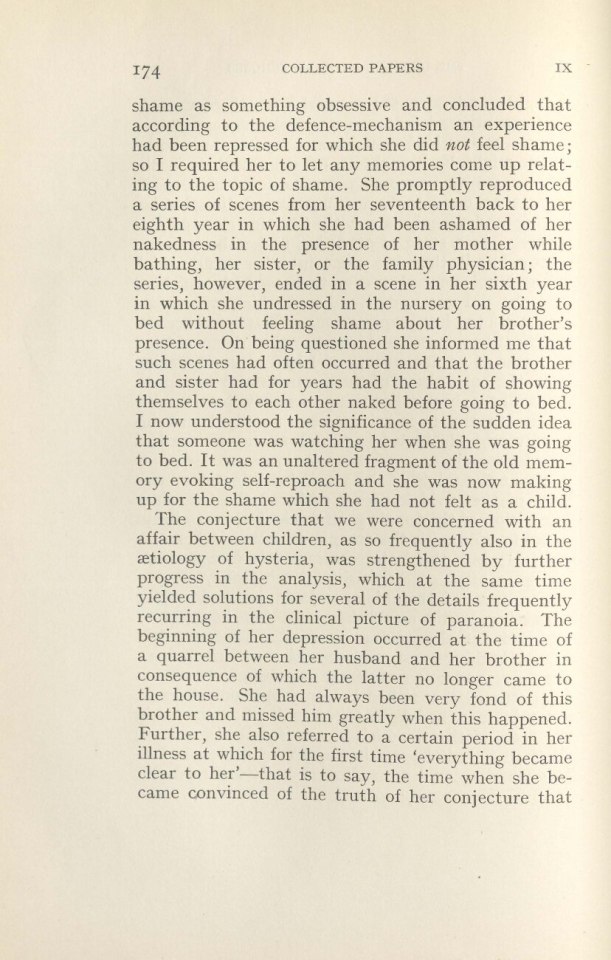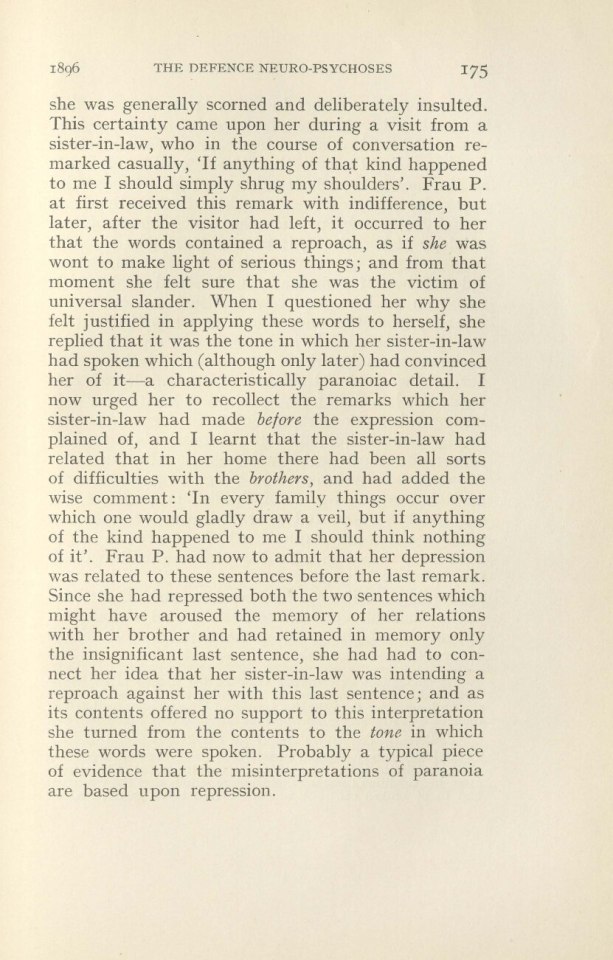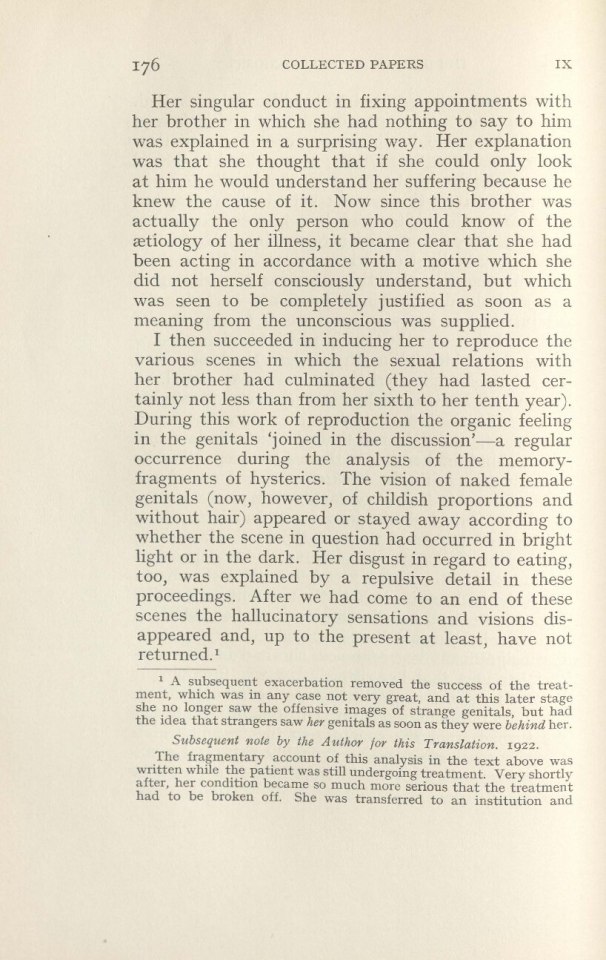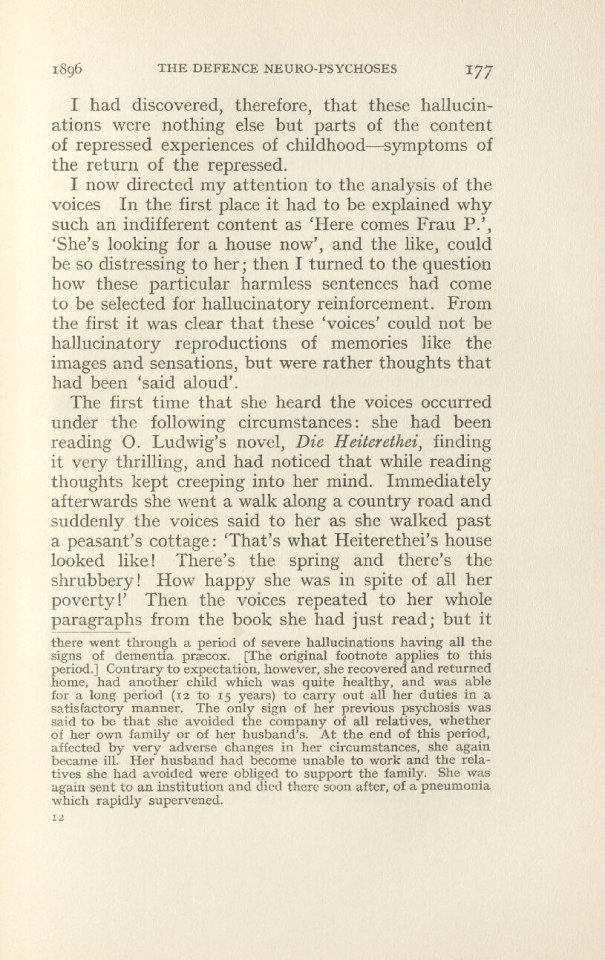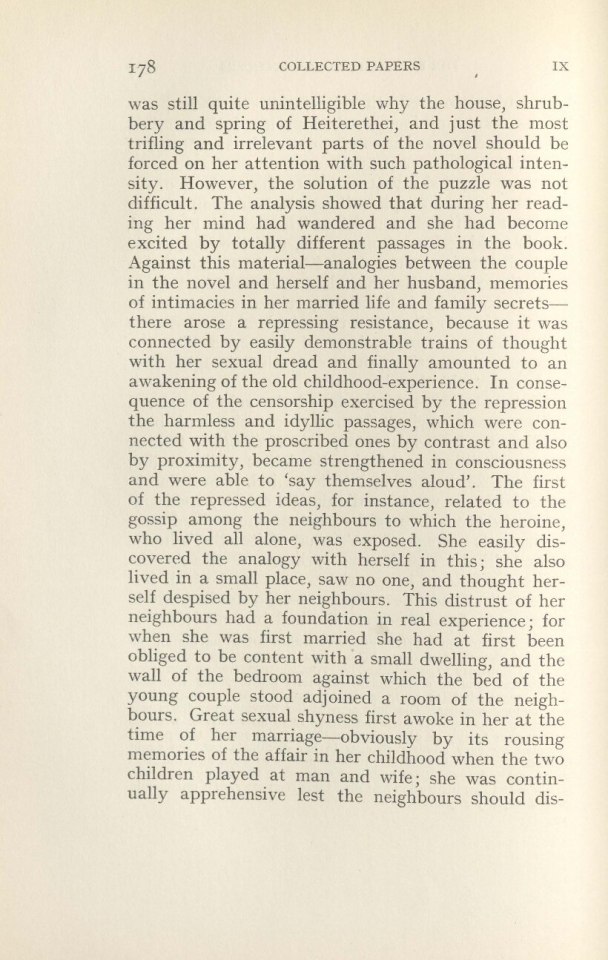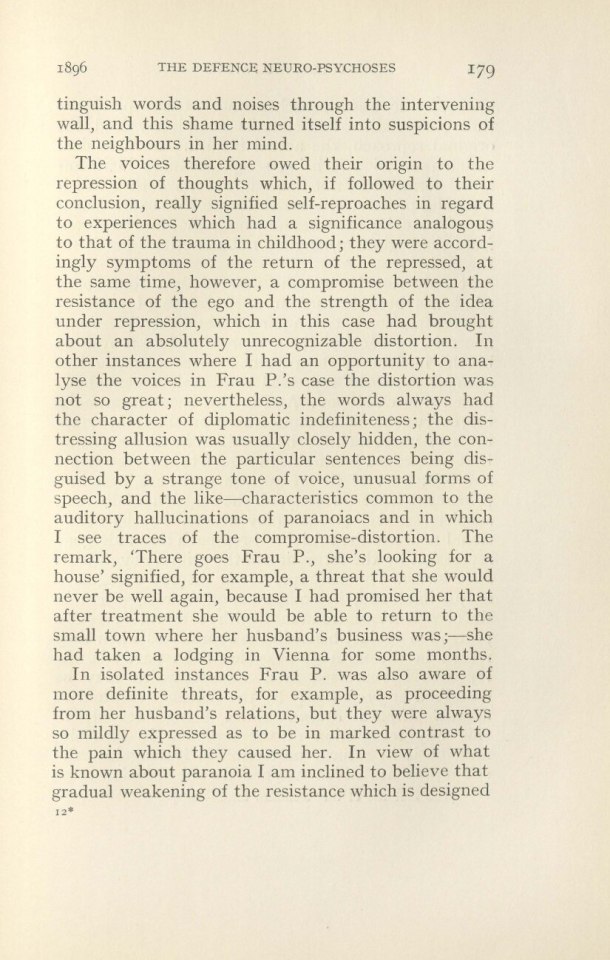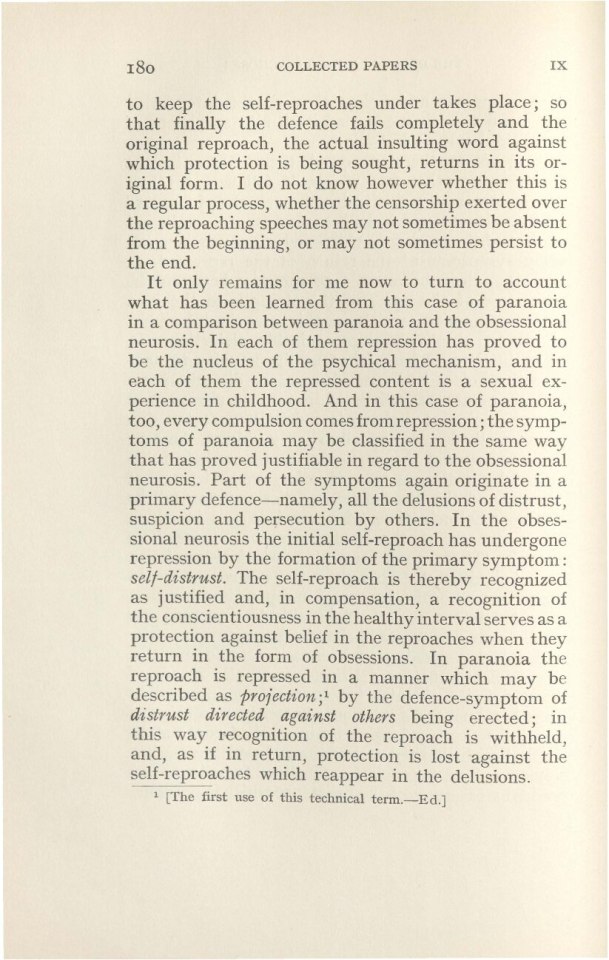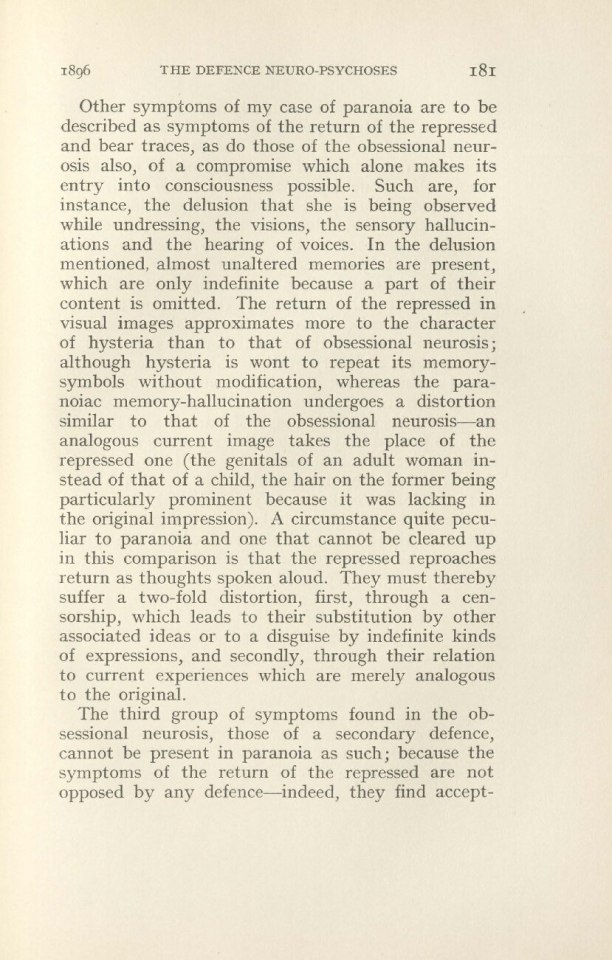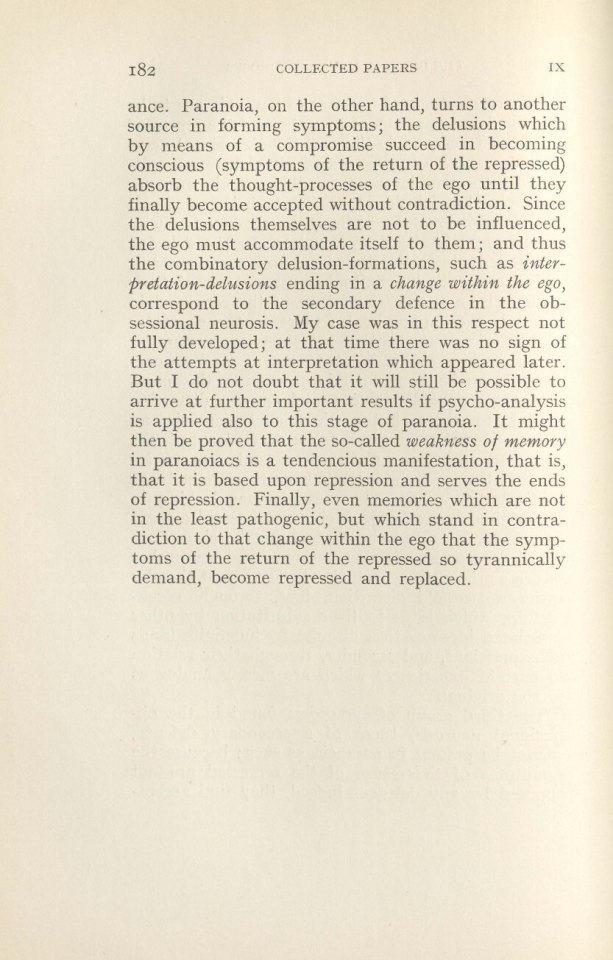S.
IX
FURTHER REMARKS ON THE DEFENCE
NEURO-PSYCHOSES!(1896)
n a short paper? published in 1894 I included
hysteria, obsessions and certain cases of acute
hallucinatory confusion under one heading as
‘Defence Neuro-Psychoses’. I did this because one
point of view showed itself as applying in common
to all these affections: their symptoms arise through
the psychical mechanism of (unconscious) defence,
that is, through an attempt to repress an intolerable
idea which was in painful opposition to the patient’s
ego. In a book since published by Dr. J. Breuer and
myself (Studien über Hysterie) I have been able by
quoting clinical observations to elucidate and illus-
trate what is meant by this psychical process of
‘defence’ or ‘repression’. Information may also be
found in it concerning the toilsome but completely
reliable method of psycho-analysis which I use in
making these investigations and by which at the
same time the investigations serve a therapeutic
purpose.My experiences in the last two years of work have
strengthened me in my surmise that defence is the
nucleus of the psychic mechanism of the neuroses
under discussion and have also made it possible for
me to give this psychological theory a clinical basis.
To my own surprise T came unexpectedly upon a? First published in the Neurologisches Zentralblatt, Oct., 1806,
No. ı0. [Translated by John Rickman.]
® See No. IV of this volume, above, p. 50.S.
156 COLLECTED PAPERS IX
few simple but narrowly definable solutions of the
problems containcd in the neuroses and in the follow-
ing paper I will give a short preliminary account
of them. I cannot in this kind of communication
bring forward the evidence on which my statements
are based, but I hope to fulfil this obligation in a
more detailed presentation.1. THE ‘SPECIFIC ZTIOLOGY OF HYSTERIA
In earlier publications Breuer and I have alreadv
expressed the opinion that the symptoms of hysteria
can be understood only by tracing them back to
“traumatic’ experiences and that these psychical
traumas are related to the patient’s sexual life.
What I have to add here, as a uniform result of my
analysis of thirteen cases of hysteria, concerns on
the one hand the nature of these sexual traumas,
and on the other hand the period of life in which
they occur. The occurrence at any time of life of
an experience in some way touching on the sexual
life, which then becomes pathogenic on account
of the generation and suppression of a painful affect,
does not suffice to bring about a hysteria. These
sexual traumas must on the contyary occur in early
childhood (before puberty) and they must consist in
actual excitation of the genital organs (coitus-Like
processes).I have found this specific determinant of hysteria
—sexual passivity ın Ihe Pre-sexual beriod— present
in all the cases of hysteria analysed (including two
men). I need here only allude to the great reduction
in the importance of the factor of hereditary dis-
position which is effected by thus establishing
accidental ztiological factors as a necessary condi-
tion; moreover, we are also thus provided with a
clue to the reason for the much greater frequency ofS.
1596 IHE DEFENCE NEURO-PSYCHOSES 157
hysteria in the female sex, which even in childhood
is more likely to provoke sexual assaults.The more obvious objections to this theory will
probably be the following: that sexual assaults on
small children occur too frequently for them to be
of great ztiological importance when they can be
confirmed; or else that such experiences must remain
ineffective for the very reason that they happen to
a sexually undeveloped person; further, that one
must guard against instigating patients to osten-
sible reminiscences of this kind by a cross-examin-
ation and guard against believing the romances which
they themselves invent. In reply to the latter ob-
jections we may ask the favour that on this obscure
topic no one should pass too certain a judgement
before he has himself practised the only method
which can throw light upon it—psycho-analysis, the
method of making conscious what was previously
unconscious.' The essential element in the first-
ınentioned objections is disposed of when we re-
member that it is not the experience itself which
acts traumatically, but the memory of it when this is
re-animated after the subject has entered upon
sexual maturity.My thirteen cases of hysteria were all of them
severe,; all of them had symptoms of many years
duration, a few after long and fruitless treatment
in institutions. The infantile traumas which analysis
discovered in these severe cases must without ex-
ception be described as grave sexual injuries; some
of them were absolutely appalling. Most prominent
among the people who were guilty of these abuses
with all their serious consequences were nursemaids,% I myself am inclined to think that the tales of outrage which
hysterics so frequently relate may be obsessive fictions which arise
in the memory-trace of the trauma that occurred in childhood.S.
I 58 COLLECTED PAPERS IN
governesses, or domestic servants, to whose care
children are all too thoughtlessiy abandoned, and
teachers and tutors appear regrettably often; in
seven of the thirteen cases, however, the assaults
were perpetrated by innocent childish assailants,
mostly brothers, who had for years carried on some
kind of sexual relation with somewhat younger
sisters. The course of events was probably in all
cases similar to that which we were able to follow
with certainty in some individual cases—namcly,
the boy was first misused by a person of the female
sex, by which his libido was prematurely awakened
and then a few years later he committed a sexual
aggression reproducing exactly the procedure to
which he himself had been subjected.I must exclude active masturbation from the list
of sexual noxie occurring in early childhood that
are pathogenic for hysteria. Although indeed it
may be very frequently found in cases of hysteria,
this is due to the circumstance that masturbation
is much more often the consequence of abuse or
seduction than is generally supposed. It is by no
means rare for both of the young couple to fall ill
of a defence neurosis at a later date, the brother
with obsessions, the sister with hysteria, which
naturally gives the appearance of a familial neurotic
disposition. This pseudo-heredity, however, is ex-
plained now and then in surprising ways; on one
occasion I was able to observe a brother, sister and
a somewhat older male cousin who were all ill. I
learnt from the analysis which I undertook with the
brother that he suffered from self-reproaches for
being the cause of his sister’s illness; he had been
seduced by his cousin, who in his turn—as was known
in the family—had himself been the vietim of his
nursemaid.S.
1856 THE DEFENCE NEURO-PSYCHOSES 159
I cannot say for certain up to what age-limit
sexual injury falls within the ztiology of hysteria;
but T doubt whether sexual passivity after the eighth
to tenth year can evoke repression in the absence of
previous experiences of the same kind. The lower
limit extends as far as memory itself, that is, there-
fore, to the tender age of from one and a half to
two years! (Two cases.) In a number of my cases
the sexual trauma (or series of traumas) occurred
in the third or fourth year. I should not myself
give credence to these singular revelations if they
had not been proved worthy of belief by the part
they played in the subsequent development of the
neurosis. In every case a number of morbid symp-
toms, habits, and phobias is only to be accounted
for by going back to these experiences of childhood,
and the logical structure of the neurotic manifest-
ations makes it impossible to reject these faithfully
preserved memories which emerge from among the
experiences of childhood. It would, indeed, be quite
useless to question an hysteric outside analysis about
these traumas in childhood; their traces are never
to be found in conscious memory, only in the symp-
toms of illness.All the experiences and excitements which in the
period of life after puberty prepare the way for or
occasion the outbreak of hysteria can be proved to
act only because they awaken the memory-trace of
those traumas in childhood; this memory-trace does
not become conscious but leads to a liberation of
the affect and to repression. In close accord with
this view of the part played by the traumas occurring
in later life is the circumstance that they are not
subject to the striet conditions governing the traumas
of childhood, but may vary in intensity and quality
from actual sexual assaults to mere sexual over-S.
160 COLLECTED PAPERS In
tures, witnessing sexual acts by others, or being told
about sexual matters.*
In my first paper on the defence neuroses it was
left unexplained how the efforts of previously healthy
ersons to forget some traumatic experience of this
kind could have the result of really produeing therepression intended and of thereby opening the door
to a defence neurosis. It could not lie in the nature
of the experiences, because other people remain well
in spite of similar incitements t0 illness. Hysteria
could not therefore be fully cxplained as the effeet
of the trauma, one had to acknowledge that the
disposition to hysterical reaction had already existed
before the trauma.Now the subsequent effect of an infantile sexual
trauma can fill the place either totally Or partiallyof this indefinite hysterical disposition. “Repression”
of the memory of a painful sexual experience in
maturer years is possible only for those people in
whom this experience can re-activate the inemory-
trace of an infantile trauma.ı In a paper on the Anxiety-Neurosis (see NO. Y of this volume,
p. 87), I mentioned that “anziety-neurosis can be evoked in maturing
ars by_ tbeir first meeting with the sexual problem; in these cases
itis typically combined with hysteria’. Inow know that the occasion
Ich such “virginal Waxiety' breaks out in yonıE girls does not
azed vepresent their first encounter with sexuality; but that an
experience of & sexually passive nature had previousiy occurred in
their childhood, the memory of which is awakened by the “ürst
encounter'.SR psychological theory of repression should. also hrow Night
on the question why It is only ideas with a Sual content that cat,
De repressed. The YTollowing hints may assist us: The formation of
ideas with a sexual content produces, as is well-knowD, exeitation-‚rocesses in the genital organs Similar to sexual experience itself.
may suppose that this somatic exeitation ransposes itself into
the ‚psychical sphere. As a rule this kind of effect is much strongermi sit
raiting eftect of the Tecollection will be very uch stronger than
hat of the experience itself; because in the meantime puberty hasS.
Obsessiona] ideas likewise Prfesuppose a sexual
Xperience jn Childhood (different in nature from
that in hysteria), The x iology of the two defencehenia and Anxiety-neurosis, The latter are direct
Tesults of the Sexual noxig themselves, asIhave shown
ina Paper on the Anxiety-neurosis (1895) ;1 the two
defence Neuroses are the indireet Consequences of
Sexual noxig Occurring before the onset of sexual
Mmaturity, that is, Consequences of the Psychical
MemMory-traces of these Noxix. The UrTENt causes
which Produce Reurasthenia and Anxiety-neurogis
frequently Play at the same time the Part of inciting
causes in the defence Neuroses, on the other hand
ci00d Play the same part
rein GPacity of te Sexual
6 tion of his Kund between
Ei enPPears to De te ‚Psychological conar-
Ir: delay in the Kulting of the soxua,
tl 'ncıversion o;
h004 act Subsequentiy as Jresh expeyienoe
ver, MnConsCjousz,, IT must Postpone Psyc| ological
ons of wider Zunge until anochen time. Let me Say, however,
eat! here Feferred to does not Coincidewith Puberty, but comes earlier eighth to tenth yea,
"See No. Y of this volume, above, p. 76S.
162 COLLECTED PAPERS IX
as in hysteria ;it is here, however, no longer a question
of sexual passivity, but rather of aggressive acts
performed with pleasure and of pleasurable parti-
cipation in sexual acts—of sexual activity, therefore.
This difference in the atiological conditions explains
why the obsessional neurosis appears to favour
the male sex.In all my cases of obsessional neurosis I have,
moreover, found a substratum of hysterical symp-
toms which can be traced back to a scene of sexual
passivity of earlier date than the pleasurable act-
ivity. I surmise that- this coincidence is a regular
one and that early sexual aggressivity always implies
a previous experience of seduction. Nevertheless,
I can as yet give no complete presentation of the
xtiology of the obsessional neurosis; I simply have
the impression that the decision whether hysteria
or obsessional neurosis will arise on the basis of the
infantile traumas depends on temporal factors in the
development of the libido.The nature of the obsessional neurosis permits of
description in a simple formula :—Obsessions are
always reproaches ve-emerging in a transmuted form
under repression—veproaches which invariably velate
to a sexual deed performed with pleasure in childhood.
To illustrate this statement it will be necessary to
give a description ofthe typical course of an obsessional
neurosis.In the first period, that of childish immorality,
occur the experiences containing the germ of the
neurosis which develops later; first of all in very
early. childhood the experiences of sexual seduction
that make subsequent repression possible, then the
deeds of sexual aggression against the opposite sexwhich appear later as acts to which self-reproach
becomes attached.S.
1806 THE DEFENCE NEURO-PSYCHOSES 163
This period is brought to a close by the onset of
sexual ‘maturity’, often itself premature. No self-
reproach becomes connected with the memories of
those pleasurable activities, and the relation with
the initial passive experience makes it possible to
repress them and substitute for them a primary
defence-symptom—often only after conscious and re-
membered efforts. Conscientiousness, shame and
self-distrust are the kind of symptoms which intro-
duce the third period, that of apparent health, or
better, that of successful defence.The next period, that of illness, is distinguished
by the return of the repressed memories, i. e. by
failure of the defence; it is doubtful whether the
awakening of these memories usually occurs accident-
ally or spontaneously or as a kind of by-product in
consequence of current sexual disturbances. The re-
animated memories and the self-reproach which is
built up on them, however, never appear in con-
sciousness unchanged. The obsessional idea and the
obsessive affects which appear in consciousness and
take the place of the pathogenic memory in con-
scious life are compromise-formations between the
repressed and the repressing ideas.In order to describe clearly and with probable
accuracy the processes of repression, the return of
the repressed, and the formation of pathological
compromise-ideas, one must resolve upon quite
definite concepts in regard to the substratum under-
Iying mental processes and consciousness. So long
as one avoids this one must be content with the
following rather figurative remarks: There are two
forms of the obsessional neurosis, according to
whether the memory-content alone of the deed which
evokes reproach has forced itself into consciousness,
or whether the affect of reproach attaching to it is
118S.
164 COLLECTED PAPERS IR
also present. To the first class belong the typical
cases of obsessional ideas, in which the patient’s
attention is directed to the content, an indefinite
affect of discomfort merely being felt, whereas the
affect of self-reproach would alone be suited to the
content of the obsessional idea. The content of the
obsessive act in childhood is changed in a twofold
manner before it emerges as an obsessional idea:
first, something present is substituted for some-
thing past, secondly, something sexual is replaced by
something analogous but not sexual. Both these
alterations are the effect of the tendency to repres-
sion, still in operation—a tendency which we should
ascribe to the ‘ego’. The influence of the re-
animated pathogenic memory is shown by the fact
that the content of the obsessional idea is still partly
identical with what is repressed, or is derived from
it by means of a logical train of thought. If one
reconstructs by means of the psycho-analytic method
the development of a single obsessional idea one finds
that two different trains of thought have been stirred
by a recent impression; the one which proceeds via
the repressed memory proves to be as correctly and
logically formed as the other, although it is incapable
of becoming conscious and is insusceptible of correc-
tion. If the results of the two psychical operations
do not harmonize what happens is not a logical
reconciliation of the contradiction between the two,
but instead, alongside the normal thought-process,
there appears in consciousness, as a compromise
between the resistance and the pathological thought-
process, an apparently absurd obsessional idea. If
both trains of thought point to the same end they
reinforce each other, so that we find a normally
developed thought-process now behaving psychically
like an obsessional idea. Wherever a neurotie com-S.
1896 THE DEFENCE NEURO-PSYCHOSES 165
hulsion makes its appearance in psychical life it
arises in repression. Öbsessional ideas have, so to
say, a forced currency psychically, not on account of
their intrinsic value, but on account of the source
from which they arise or which has furnished a
contribution to their value.The second form of obsessional neurosis comes
about if what has compelled representation for itself
in conscious mental life is not the repressed memory-
content but the self-reproaches that are likewise
repressed. The affect of reproach can with the aid
of some psychical reinforcement transmute itself
into any other unpleasant affect; when this has
happened there is nothing to hinder the substituted
affect any longer from becoming conscious. Thus
self-reproach (for having performed a sexual deed in
childhood) can easily transform itself into shame
(lest another person should come to hear about it),
into hypochondriacal anziety (lest some bodily injury
should result from the action which evoked the
self-reproach), into dread of the community (fear of
punishment by the world at large for the lapse),
into religious anziety, into delusions of reference
(dread of betraying the deed), into dread of tempt-
ation (justified mistrust in the personal strength of
moral resistance), and so on. Together with this
the memory of the deed which evokes reproach may
either be represented in consciousness too, or be
completely withhell—a fact which renders exact
diagnosis much more difficult. Many cases which
on superficial examination would be regarded as
ordinary (neurasthenic) hypochondria belong to this
group of obsessional affects; so-called ‘periodic neur-
asthenia’ or ‘periodic melancholia’ in particular
appears to be reducible with unexpected frequency
to obsessional affects and obsessional ideas—a re-S.
166 COLLECTED PAPERS IX
cognition that is therapeutically by no means un-
important. :In addition to these compromise-symptoms, which
signify the return of the repressed and consequently
a collapse of the defence originally aimed at, the
obsessional neurosis forms a series of further symp-
toms quite different in origin. The ego seeks to
ward off those derivatives of the original repressed
memory and in this struggle for defence creates
symptoms which may be grouped together as ‘second-
ary defence' symptoms. These are all ‘Protective
measures’ which had already performed good service
in the struggle with the obsessional ideas and affects.
If these aids to defence are really successful in once
more repressing the symptoms due to the return of
the repressed which have been forced upon the ego,
then the compulsion is transferred to the protective
measures themselves and creates a third form of
‘obsessional neurosis’—that of obsessive actions. These
are never primary, never anything but defensive;
they never contain anything of an aggression; psych-
ical analysis of them shows that—in spite of all their
oddity—they are to be fully explained by tracing
them back to the obsessive memory which they are
combating.To take one example only: an eleven-year-old bov
had instituted the following obsessive ceremonial
before going to bed. He did not sleep until he had
told his mother in the minutest detail all the events
of thejday; there must be no scraps of paper or
other rubbish on the carpet of the bedroom; the bed
must be pushed right up to the wall; three chairs
must stand by it and the pillows must lie in a partic-
ular way. In order to get to sleep he himself must
first kick out a certain number of times with both
legs and then lie on his side.—This was explained inS.
1896 THE DEFENCE NEURO-PSYCHOSES 167
the following manner: years before a servant-girl
who had to put the handsome boy to bed took the
opportunity of lying upon him and abusing him
sexually. Later on when this memory was awakened
by a recent experience, it manifested itself in con-
sciousness in the form of a compulsion to perform
the ceremonial described; its meaning was easily
guessed and was established point by point by means
of psycho-analysis: the chairs by the bedside and
pushing the bed against the wall—so that no one
could later come near the bed; the pillows arranged
in a certain way—so that they should be arranged
differently from the way they were on that evening;
kicking the legs—pushing away the person lying on
him; sleeping on his side—because in the scene he
lay on his back; the circumstantial confession to
his mother—because he had concealed from her this
and other sexual experiences in obedience to his
seductress; finally, keeping clean the floor of his
bedroom—because this was the principal reproach
that he had previousliy had to endure from his
mother.Secondary defence against obsessional ideas may be
brought about by an enforced diversion on to other
thoughts, in content as different as possible; there-
fore when this succeeds obsessive speculating results
and the thoughts are regularly occupied with abs-
tract, transcendental topics, because the repressed
ideas were always of a sensual kind. Or else the
patient tries to master each particular idea by logic
and by appeals to his conscious memory; this leads
to obsessive thinking, the compulsion to test every-
thing, and to folie du doute. The patient’s prefer-
ence for perception over memory in making these
tests first leads him, and later compels him, to
amass and preserve all objects with which he comesS.
168 COLLECTED PAPERS Ix
into contact. Secondary defence against the obses-
sional affects calls into being a still wider series of
protective measures, which may be transformed into
obsessive acts. These may be grouped according to
their tendencies: enitential measures (burdensome
ceremonials, the observation of numbers) precaut-
ionary measures (all kinds of phobias, superstitions,
pedantry, exaggeration of the primary symptom of
conscientiousness), dread of betrayal (collecting paper,
misanthropia), hebetude (dipsomania). Among these
obsessive actions and impulses the phobias play the
greatest part in circumscribing the patient’s life.
There are cases in which one can observe the way
in which the compulsion transfers itself from the
idea or from the affect on to the defensive measure;
others in which the compulsion oscillates periodically
between the symptom due to the return of the
repressed and the symptom of secondary defence;
and still other cases in which no obsessional idea is
formed at all, but in which the repressed memory
is replaced forthwith by the apparently primary
defensive measure. The stage which is otherwise
attained only after a defensive battle and which
concludes the development of an obsessional neurosis
is here reached in one leap. Severe cases of this
disease end in the obsessive ceremonial becoming
firmly established, in ‚a general folie du doute, or in
an eccentric way of life conditioned by phobias.
That the obsessional idea and all its derivatives
find no credence is probably due to the fact that the
defence-symptom of conscientiousness is formed at
the onset of repression, and that this symptom has
a similar obsessional value. The certainty that a
moral life has been lived throughout the whole
period of successful defence makes it impossible to
give credence to the self-reproach involved in theS.
1896 THE DEFENCE NEURO-PSYCHOSES 169
obsessional idea. Only transitorily, upon the appear-
ance of a new obsessional idea or now and then in
a condition of melancholic exhaustion of the ego, do
the morbid symptoms of the return of the repressed
compel belief. The ‘compulsion’ of the psychical
productions here described has in general nothing
to do with belief in them and is also not to be con-
founded with that factor which one designates as
the ‘strength’ or intensity’ of an idea. Its essential
character is rather its insolubility through conscious
psychical activity, and this character undergoes no
change whether the idea to which the compulsion
adheres is strongly or weakly, more or less intensely,
‘suffused’, ‘endowed with cathexis’, and so on.The cause of this invulnerability of the obsessional
idea or its derivatives, however, is only its connection
with the repressed memory of early childhood; for
if it is possible to succeed in making this connection
conscious—and psycho-therapeutic methods appear
to be alrcady competent to do so—we find that at
the same time the compulsion is removed.III. ANALYSIS OF A CASE OF CHRONIC PARANOIA
For a long time I have entertained the suspicion
that paranoia, or groups of cases belonging to it, is
also a defence-psychosis; that is to say, that it
results from the repression of painful memories, as
do hysteria and obsessions, and that the form of
the symptoms is determined by the content of the
repressed memory. A special path or mechanism of
repression, however, must be peculiar to paranoia;
just as in hysteria the repression is eifectively estab-
lished by means of conversion into bodily innervation,
and in the obsessional neurosis by means of sub-
stitution (displacement along certain associated chan-
nels). I observed several cases which favoured thisS.
170 COLLECTED PAPERS IA
view, but had found none which proved it until I
had the opportunity some months ago through the
kindness of Dr. J. Breuer of undertaking psycho-
analytic treatment of an intelligent woman, aged
thirty-two, in whose case the diagnosis of chronic
paranoia was undeniable. I am already here re-
porting a few of the points which it was possible to
obtain light upon in the course of this piece of work,
because I have no opportunity of studying paranoia
except in very isolated cases, and because I consider
it possible that these observations may induce a
psychiatrist more favourably situated than I to
bring the factor of ‘defence’ into its rightful place in
the discussion, now so brisk, on the nature and
psychical mechanism of paranoia. On the basis of
a single observation I should naturally not think of
going further than some such conclusion as this:
this case is a defence-psychosis and in the category
of paranoia there are probably others like it.Frau P., thirty-two - years of age, three years
married and the mother of a two-year-old child, was
born of parents who were not nervous; her brother
and sister I knew, however, to be also neurotic. It
is doubtful whether she was not temporarily depressed
and confused in her judgement in her twenties; in
later years she was healthy and active until six
months after the birth of her child when she showed
the first symptoms of her present illness. She became
uncommunicative and distrustful, showed a dis-
inclination to meet her husband’s family and com-
plained that the neighbours in the small town where
she lived had changed towards her and were now rude
and disagreeable. By degrees these complaints in-
creased in intensity, though not in definiteness:
people had something against her, although she had
no notion what it could be; there was not the slightestS.
1896 THE DEFENCE NEURO-PSYCHOSES 17I
doubt that everyone—relations and friends—had
ceased to respect her, and that they did all sorts of
things to wound her; she racked her brains to find
the reason for this, but could not discover it. Some-
what later she complained that she was being
watched, that people read her thoughts, that they
knew everything that went on in her house. One
afternoon she suddenly got the idea that people
watched her undressing at night. From that time
onwards she employed the most complicated pre-
cautions when undressing, slipping into bed in the
dark and undressing under the bedclothes. Since
she cut herself off from the world, ate little, and was
very depressed, she was sent in the summer of 1895
to a hydrotherapeutic institution. There new symp-
toms appeared and those she already had became
exacerbated. In the previous spring when alone
one day with a housemaid she had suddenly had a
sensation in her genitals and the idea came into her
mind that the girl had just then had an improper
thought. This sensation became more frequent in
the summer and was almost continuous, her genitals
felt ‘as if there was a heavy hand there’. Then she
began to see images which horrified her—hallucin-
ations of naked females, in particular an uncovered
vulva with hair; occasionally male genitals as well.
The vision of the hairy vulva and the pliysical sen-
sation in the genital organs usually occurred simul-
taneously. These images were very tormenting to
her, for they recurred regularly whenever she was
in the company of a woman, and she supposed that
she was seeing the woman in a state of most unseemly
nakedness and that at the same moment the woman
was having the same vision of her (!). Simultane-
ously with these visual hallucinations, which after
their first appearance in the institution disappearedS.
172 COLLECTED PAPERS IX
again for several months, voices which she did not
recognize and which she could not explain began to
pester her; when she was in the street they said,
‘That is Frau P. There she goes! Where’s she
going?’ Some one commented on her every move-
ment and action, occasionally she heard threats and
reproaches. AIl these symptoms became worse if
she was among several people or even when she was
in the street; she therefore refused to go out and
then declared that eating disgusted her, so that her
condition became rapidly worse.I gathered this from her when she came to Vienna
in the winter of 1895 to be treated by me. I have
described the case circumstantially in order to
demonstrate that we are really dealing here with
a quite frequent type of chronic paranoia; the details
of the symptoms and of her conduct which will be
adduced later will also support this conclusion. At
the time she concealed from me any delusions con-
cerning the meaning of the hallucinations or per-
haps they had really not yet been formed; her
intelligence was unimpaired; the only unusual thing
I was informed of was that she had repeatediy made
appointments with her brother, who lived in the
neighbourhood, in order to tell him something im-
portant but had never actually told him anything.
She never spoke about her hallucinations and towards
the end said practically nothing about the griev-
ances and persecutions which she suffered from.What I have to report about this patient concerns
the ztiology of the case and the mechanism of her
hallucinations. I discovered the ztiology while I
was applying Breuer’s method, exactly as in a case
of hysteria, for the investigation and removal of the
hallucinations. I started from the assumption that
there must be in this case of paranoia unconsciousS.
1596 THE DEFENCE NEURO-PSYCHOSES 173
thoughts and repressed memories, as there were in
the two other defence neuroses which were known
to me—unconscious thoughts and repressed memories
which might be brought to consciousness as in the
other cases by overcoming a certain resistance. The
patient at once confirmed my expectation by be-
having under analysis exactly like, for example, an
hysteric; in a state of attention under the pressure
of my hand! thoughts came into her mind which
she did not remember ever to have had, which at
first she did not understand and which were quite
contrary to her expectations. The presence of
significant unconscious ideas was thus demonstrated
in a case of paranoia too, and I had hopes of tracing
back the compulsion of the paranoia also to repres-
sion. The only peculiar thing was that the thoughts
arising in the unconscious were usually heard in-
wardly or hallucinated in the same way as she had
heard the voices.About the origin of the visual hallucinations or at
least of the vivid images I gathered the following:
Ihe vision of the female genitals came almost always
in connection with the organic sensation in her own
genitals; but the latter was much more constant
and very often occurred without the vision.The first of these images had appeared in the
hydrotherapeutic establishment a few hours after
she had actually seen a number of women naked
in the bathing-room, and proved therefore t6 be a
simple reproduction of a real impression. It was to
be presumed that it had been repeated only because
great interest had been taken in it. She then said
she had at the time felt shame for those women;
she had herself been ashamed to be seen naked as
long as she could remember. I had to regard this1 CH Studien über Hysterie.
S.
174 COLLECTED PAFPERS IR
shame as something obsessive and concluded that
according to the defence-mechanism an experience
had been repressed for which she did not feel shame;
so I required her to let any memories come up relat-
ing to the topic of shame. She promptly reproduced
a series of scenes from her seventeenth back to her
eighth year in which she had been ashamed of her
nakedness in the presence of her mother while
bathing, her sister, or the family physician; the
series, however, ended in a scene in her sixth year
in which she undressed in the nursery on going to
bed without feeling shame about her brother’s
presence. On being questioned she informed me that
such scenes had often occurred and that the brother
and sister had for years had the habit of showing
themselves to each other naked before going to bed.
I now understood the significance of the sudden idea
that someone was watching her when she was going
to bed. It was an unaltered fragment of the old mem-
ory evoking self-reproach and she was now making
up for the shame which she had not felt as a child.The conjecture that we were concerned with an
affair between children, as so frequently also in the
xtiology of hysteria, was strengthened by further
progress in the analysis, which at the same time
yielded solutions for several of the details frequently
recurring in the clinical picture of paranoia. The
beginning of her depression occurred at the time of
a quarrel between her husband and her brother in
consequence of which the latter no longer came to
the house. She had always been very fond of this
brother and missed him greatly when this happened.
Further, she also referred to a certain period in her
illness at which for the first time “everything became
clear to her’—that is to say, the time when she be-
came convinced of the truth of her conjecture thatS.
1896 THE DEFENCE NEURO-PSYCHOSES 175
she was generally scorned and deliberately insulted.
This certainty came upon her during a visit from a
sister-in-law, who in the course of conversation re-
marked casually, ‘If anything of that kind happened
to me I should simply shrug my shoulders’. Frau P.
at first received this remark with indifference, but
later, after the visitor had left, it occurred to her
that the words contained a reproach, as if she was
wont to make light of serious things; and from that
moment she felt sure that she was the victim of
universal slander. When I questioned her why she
felt justified in applying these words to herself, she
replied that it was the tone in which her sister-in-law
had spoken which (although only later) had convinced
her of it—a characteristically paranoiac detail. I
now urged her to recollect the remarks which her
sister-in-law had made before the expression com-
plained of, and I learnt that the sister-in-law had
related that in her home there had been all sorts
of difficulties with the brothers, and had added the
wise comment: ‘In every family things occur over
which one would gladly draw a veil, but if anything
of the kind happened to me I should think nothing
of it’. Frau P. had now to admit that her depression
was related to these sentences before the last remark.
Since she had repressed both the two sentences which
might have aroused the memory of her relations
with her brother and had retained in memory only
the insignificant last sentence, she had had to con-
nect her idea that her sister-in-law was intending a
reproach against her with this last sentence; and as
its contents offered no support to this interpretation
she turned from the contents to the Zone in which
these words were spoken. Probably a typical piece
of evidence that the misinterpretations of paranoia
are based upon repression.S.
176 COLLECTED PAPERS INS
Her singular conduct in fixing appointments with
her brother in which she had nothing to say to him
was explained in a surprising way. Her explanation
was that she thought that if she could only look
at him he would understand her suffering because he
knew the cause of it. Now since this brother was
actually the only person who could know of the
ztiology of her illness, it became clear that she had
been acting in accordance with a motive which she
did not herself consciously understand, but which
was seen to be completely justified as soon as a
meaning from the unconscious was supplied.I then succeeded in inducing her to reproduce the
various scenes in which the sexual relations with
her brother had culminated (they had lasted cer-
tainly not less than from her sixth to her tenth year).
During this work of reproduction the organic feeling
in the genitals joined in the discussion’—a regular
occurrence during the analysis of the memory-
fragments of hysterics. The vision of naked female
genitals (now, however, of childish proportions and
without hair) appeared or stayed away according to
whether the scene in question had occurred in bright
light or in the dark. Her disgust in regard to eating,
too, was explained by a repulsive detail in these
proceedings. After we had come to an end of these
scenes the hallucinatory sensations and visions dis-appeared and, up to the present at least, have not
returned.!* A subsequent exacerbation removed the success of the treat-
ment, which was in any case not very great, and at this later stage
she no longer saw the offensive images of strange genitals, but had
the idea that strangers saw her genitals as soon as they were behind her.Subsequent note by the Author for this Translation. 1922.
The fragmentary account of this analysis in the text above was
written while the patient was still undergoing treatment. Very shortly
after, her condition became so much more serious that the treatment
had to be broken off. She was transferred to an institution andS.
1596 THE DEFENCE NEURO-PSYCHOSES 177
I had discovered, therefore, that these hallucin-
ations were nothing else but parts of the content
of repressed experiences of childhood—symptoms of
the return of the repressed.I now directed my attention to the analysis of the
voices In the first place it had to be explained why
such an indifferent content as ‘Here comes Frau P.’,
‘She’s looking for a house now’, and the like, could
be so distressing to her; then I turned to the question
how these particular harmless sentences had come
to be selected for hallucinatory reinforcement. From
the first it was clear that these ‘voices’ could not be
hallucinatory reproductions of memories like the
images and sensations, but were rather thoughts that
had been ‘said aloud’.The first time that she heard the voices occurred
under the following circumstances: she had been
reading ©. Ludwig’s novel, Die Heiterethei, finding
it very thrilling, and had noticed that while reading
thoughts kept creeping into her mind. Immediately
afterwards she went a walk along a country road and
suddenly the voices said to her as she walked past
a peasant’s cottage: “That’s what Heiterethei’s house
looked like! ’There’s the spring and there’s the
shrubbery! How happy she was in spite of all her
poverty!’ Then the voices repeated to her whole
paragraphs from the book she had just read; but itthere went through a period of severe hallucinations having all the
signs of dementia precox. [The original footnote applies to this
period.] Contrary to expoctation, however, she recovered and returned
home, had another child which was quite healthy, and was able
for a long period (t2 to 15 years) to carry out all her duties in a
satisfactory manner. The only sign of her previous psychosis was
said to be that she avoided the company of all relatives, whether
of her own family or of her husband’s. At the end of this period,
affected by very adverse changes in her circumstances, she again
became ill. Her husband had become unable to work and the rela-
tivos she had avoided were obliged to support the family. She was
again sent to an institution and died there soon after, of a pneumonia
which rapidly supervened.5
S.
178 COLLECTED PAPERS j Ix
was still quite unintelligible why the house, shrub-
bery and spring of Heiterethei, and just the most
trifling and irrelevant parts of the novel should be
forced on her attention with such pathological inten-
sity. However, the solution of the puzzle was not
difficult. The analysis showed that during her read-
ing her mind had wandered and she had become
excited by totally different passages in the book.
Against this material—analogies between the couple
in the novel and herself and her husband, memories
of intimacies in her married life and family secrets—
there arose a repressing resistance, because it was
connected by easily demonstrable trains of thought
with her sexual dread and finally amounted to an
awakening of the old childhood-experience. In conse-
quence of the censorship exercised by the repression
the harmless and idyllic passages, which were con-
nected with the proscribed ones by contrast and also
by proximity, became strengthened in consciousness
and were able to ‘say themselves aloud’. The first
of the repressed ideas, for instance, related to the
gossip among the neighbours to which the heroine,
who lived all alone, was exposed. She easily dis-
covered the analogy with herself in this; she also
lived in a small place, saw no one, and thought her-
self despised by her neighbours. This distrust of her
neighbours had a foundation in real experience; for
when she was first married she had at first been
obliged to be content with a small dwelling, and the
wall of the bedroom against which the bed of the
young couple stood adjoined a room of the neigh-
bours. Great sexual shyness first awoke in her at the
time of her marriage—obviously by its rousing
memories of the affair in her childhood when the two
children played at man and wife ; she was contin-
ually apprehensive lest the neighbours should dis-S.
1896 THE DEFENCE NEURO-PSYCHOSES 179
tinguish words and noises through the intervening
wall, and this shame turned itself into suspicions of
the neighbours in her mind.The voices therefore owed their origin to the
repression of thoughts which, if followed to their
conchusion, really signified self-reproaches in regard
to experiences which had a significance analogous
to that of the trauma in childhood; they were accord-
ingly symptoms of the return of the repressed, at
the same time, however, a compromise between the
resistance of the ego and the strength of the idea
under repression, which in this case had brought
about an absolutely unrecognizable distortion. In
other instances where I had an opportunity to ana-
lyse the voices in Frau P.’s case the distortion was
not so great; nevertheless, the words always had
the character of diplomatie indefiniteness; the dis-
tressing allusion was usually closely hidden, the con-
nection between the particular sentences being dis-
guised by a strange tone of voice, unusual forms of
speech, and the like—characteristics common to the
auditory hallucinations of paranoiacs and in which
I see traces of the compromise-distortion. The
remark, “There goes Frau P., she’s looking for a
house’ signified, for example, a threat that she would
never be well again, because I had promised her that
after treatment she would be able to return to the
small town where her husband’s business was ;—she
had taken a lodging in Vienna for some months.In isolated instances Frau P. was also aware of
more definite threats, for example, as proceeding
from her husband’s relations, but they were always
so mildly expressed as to be in marked contrast to
the pain which they caused her. In view of what
is known about paranoia I am inclined to believe that
gradual weakening of the resistance which is designed12*
S.
180 COLLECTED PAPERS I8
to keep the self-reproaches under takes place; so
that finally the defence fails completely and the
original reproach, the actual insulting word against
which protection is being sought, returns in its or-
iginal form. I do not know however whether this is
a regular process, whether the censorship exerted over
the reproaching speeches may not sometimes be absent
from the beginning, or may not sometimes persist to
the end.It only remains for me now to turn to account
what has been learned from this case of paranoia
in a comparison between paranoia and the obsessional
neurosis. In each of them repression has proved to
be the nucleus of the psychical mechanism, and in
each of them the repressed content is a sexual ex-
perience in childhood. And in this case of paranoia,
too, every compulsion comes from repression ;thesymp-
toms of paranoia may be classified in the same way
that has proved justifiable in regard to the obsessional
neurosis. Part of the symptoms again originate in a
primary defence—namely, all the delusions of distrust,
suspicion and persecution by others. In the obses-
sional neurosis the initial self-reproach has undergone
repression by the formation of the primary symptom:
self-distrust. The self-reproach is thereby recognized
as justified and, in compensation, a recognition of
the conscientiousness in the healthy intervalserves asa
protection against belief in the reproaches when they
return in the form of obsessions. In paranoia the
reproach is repressed in a manner which may be
described as Projection;! by the defence-symptom of
distrust directed against others being erected; in
this way recognition of the reproach is withheld,
and, as if in return, protection is lost against the
seli-reproaches which reappear in the delusions.3 "The first use of this technical term. —Ed.]
S.
1896 THE DEFENCE NEURO-PSYCHOSES ISI
Other symptoms of my case of paranoia are to be
described as symptoms of the return of the repressed
and bear traces, as do those of the obsessional neur-
osis also, of a compromise which alone makes its
entry into consciousness possible. Such are, for
instance, the delusion that she is being observed
while undressing, the visions, the sensory hallucin-
ations and the hearing of voices. In the delusion
mentioned, almost unaltered memories are present,
which are only indefinite because a part of their
content is omitted. The return of the repressed in
visual images approximates more to the character
of hysteria than to that of obsessional neurosis;
although hysteria is wont to repeat its memory-
symbols without modification, whereas the para-
noiac memory-hallucination undergoes a distortion
similar to that of the obsessional neurosis—an
analogous current image takes the place of the
repressed one (the genitals of an adult woman in-
stead of that of a child, the hair on the former being
particularly prominent because it was lacking in
the original impression). A circumstance quite pecu-
liar to paranoia and one that cannot be cleared up
in this comparison is that the repressed reproaches
return as thoughts spoken aloud. They must thereby
suffer a two-fold distortion, first, through a cen-
sorship, which leads to their substitution by other
associated ideas or to a disguise by indefinite kinds
of expressions, and secondly, through their relation
to current experiences which are merely analogous
to the original.The third group of symptoms found in the ob-
sessional neurosis, those of a secondary defence,
cannot be present in paranoia as such; because the
symptoms of the return of the repressed are not
opposed by any defence—indeed, they find accept-S.
182 COLLECTED PAPERS I
ance. Paranoia, on the other hand, turns to another
source in forming symptoms; the delusions which
by means of a compromise succeed in becoming
conscious (symptoms of the return of the repressed)
absorb the thought-processes of the ego until they
finally become accepted without contradietion. Since
the delusions themselves are not to be influenced,
the ego must accommodate itself to them; and thus
the combinatory delusion-formations, such as inter-
pretation-delusions ending in a change within the ego,
correspond to the secondary defence in the ob-
sessional neurosis. My case was in this respect not
fully developed; at that time there was no sign of
the attempts at interpretation which appeared later.
But I do not doubt that it will still be possible to
arrive at further important results if psycho-analysis
is applied also to this stage of paranoia. It might
then be proved that the so-called weakness of memory
in paranoiacs is a tendencious manifestation, that is,
that it is based upon repression and serves the ends
of repression. Finally, even memories which are not
in the least pathogenic, but which stand in contra-
diction to that change within the ego that the symp-
toms of the return of the repressed so tyrannically
demand, become repressed and replaced.
freud-1924-cp-1
155
–182
